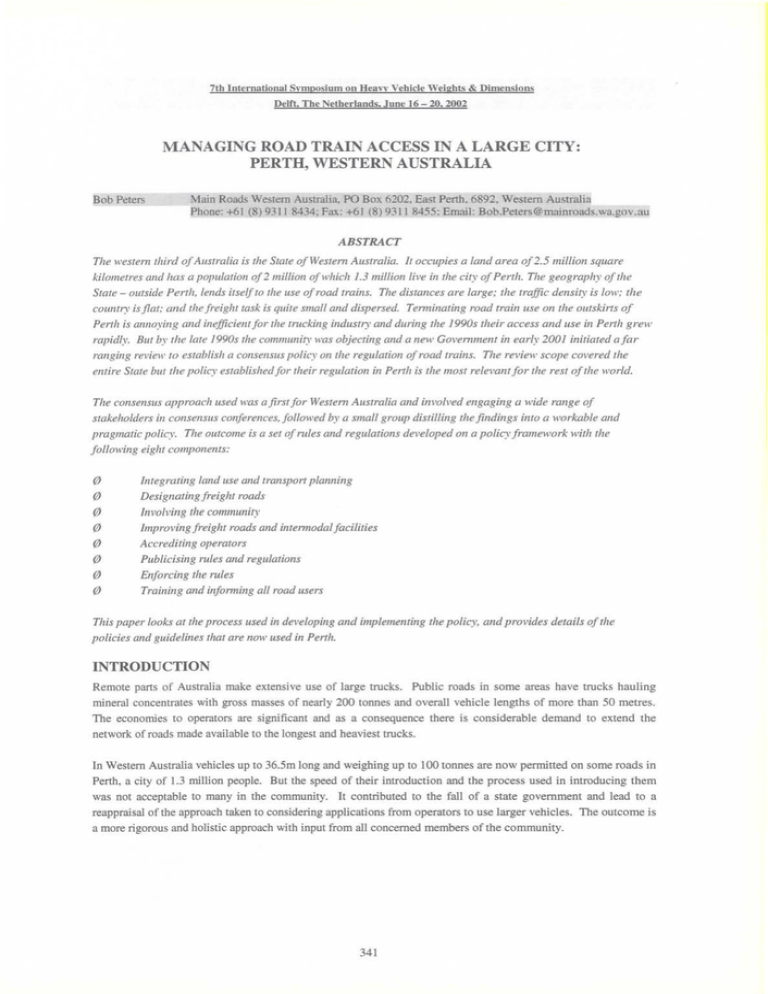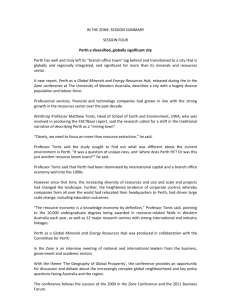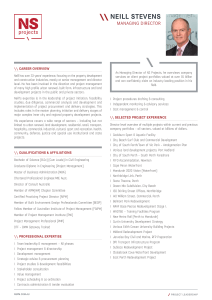MANAGING ROAD TRAIN ACCESS IN A LARGE CITY: PERTH, WESTERN AUSTRALIA
advertisement

7th International Symposium on Heavv Vehicle Weights & Dimensions Delft. The Netherlands. June 16 - 20.2002 MANAGING ROAD TRAIN ACCESS IN A LARGE CITY: PERTH, WESTERN AUSTRALIA ABSTRACT The western third of Australia is the State of Western Australia. It occupies a land area of2.5 million square kilometres and has a population of 2 million of which 1.3 million live in the city of Perth. The geography of the State - outside Perth, lends itself to the use of road trains. The distances are large; the traffic density is low; the country is flat; and the freight task is quite small and dispersed. Terminating road train use on the outskirts of Perth is annoying and inefficient for the trucking industry and during the 1990s their access and use in Perth grew rapidly. But by the late 1990s the community was objecting and a new Government in early 2001 initiated afar ranging review to establish a consensus policy on the regulation of road trains. The review scope covered the entire State but the policy established for their regulation in Perth is the most relevant for the rest of the world. The consensus approach used was afirstfor Western Australia and involved engaging a wide range of stakeholders in consensus conferences, followed by a small group distilling the findings into a workable and pragmatic policy. The outcome is a set of rules and regulations developed on a policy framework with the following eight components: @ @ Integrating land use and transport planning Designating freight roads @ Involving the community Improving freight roads and intermodaI facilities Accrediting operators @ Publicising rules and regulations @ Enforcing the rules Training and informing all road users @ @ @ This paper looks at the process used in developing and implementing the policy, and provides details of the policies and guidelines that are now used in Perth. INTRODUCTION Remote parts of Australia make extensive use of large trucks. Public roads in some areas have trucks hauling mineral concentrates with gross masses of nearly 200 tonnes and overall vehicle lengths of more than 50 metres. The economies to operators are significant and as a consequence there is considerable demand to extend the network of roads made available to the longest and heaviest trucks. In Western Australia vehicles up to 36.5m long and weighing up to 100 tonnes are now permitted on some roads in Perth, a city of 1.3 million people. But the speed of their introduction and the process used in introducing them was not acceptable to many in the community. It contributed to the fall of a state government and lead to a reappraisal of the approach taken to considering applications from operators to use larger vehicles. The outcome is a more rigorous and holistic approach with input from all concerned members of the community. 341 PERTH Perth is a city of 1.3 rrilIlion people on the western coast of Australia. Most people try and li ve close to the coast to take advantage of the Mediterranean climate - a cool wet winter and a hot dry summer. As a consequence Perth is very long - some 100 kilometres from the north to the south yet only 20 kilometres from the east to the west. It is also very spread out. Land values on the fringe are low and along with a well-developed road system there is a growing urban passenger rail network. Perth is quite flat with few serious waterways making for low cost road building. LAND USE AND TRANSPORT PLANNING Perth has been developed on the basis of a townplanning scheme - known as the Metropolitan Region Scheme (MRS), since the 1960s. This has resulted in industry and urban development in prescribed areas and the Figure 1: Perth, Australia and Its Major Roads development of roads - in the main, to serve the city. It has however meant that there has been a need to build some major roads through areas that have been suburban housing estates for a long time and this has been very difficult. The MRS also placed some road reserves in wetlands, as at the time of the MRS creation these areas were considered wastelands. This is now not the case in many people's minds and it has become very difficult to build these roads - despite the land being reserved and never having been occupied. SEAPORT The Port of Fremantle is Perth's seaport. It was originally at one location - at the mouth of the Swan River, but in the past 50 years has expanded with the development of specialised berths to the south adjacent to new industrial areas and at locations better suited to the rail and road network. This has been very successful, with one exception. The original facility has been developed as Perth's sole container terminal. Container trade has grown rapidly (355,000 TEUs in 2000/01 - up 18% on 1999/2000) and nearly all of them get to and from the Port by road. Rail access is poor to this part of the Port and in addition most containers need to be moved by road as they are going to and from dispersed warehouses in Perth. The road outcome is the need to accommodate large numbers of trucks through highly desirable urban areas on inadequate roads with the local community strongly resisting the construction of suitable roads. The truck movements in and out of the container port are significant. A survey carried out on 10 December 2001 on the access road to the Port provided the following statistics: • • • 8490 vehicles; 2345 trucks comprising 260 'long vehicle' road trains, 146 B doubles , 1158 five and six axle articulated trucks and 792 mainly smaller trucks; and 93% of truck movements took place between 7am and 7pm. About 4 million tonnes of freight were moved in and out of the port on this access road in 200010 1. CHANGING TRUCK MASS AND DIMENSION LIMITS IN PERTH Until the early 1980s trucks in Perth were no bigger than regulation limits - at the time 17m long and 38 tonnes. But the head of the State's road authority was authorised to permit larger vehicles wherever he felt it was in the interests of the community at large - on any public road. This authority stemmed from the fact that remote areas of W A had for 30 years been making extensi ve use of road trains. In these areas traffic numbers were very low, the distances were very long and the country very flat and forgiving. But these trucks wanted to get closer to the bigger towns - and Perth. In the early 1980s perrrilts were issued to allow some trucks in Perth to exceed the regulation mass limit - but not the length. This was trialled for some time. Truck and trailer combinations with a length of 17 metres and a gross mass of about 55 tonnes became quite common. In the mid 1980s this was followed by trials of two 17 metre long Canadian B-trains. These were designed to carry two 20-foot containers - without being overloaded, as was often the case with conventional 342 semi-trailer vehicles carrying two containers. The reform process was slow and cautious. But as was the practice then there was no involvement by the community or local government - something that in the present environment would not be tolerated. THE 1990S This cautious approach continued until the early 1990s. Then changes took place rapidly with the Government of the day keen to make economic progress. The State's economy grew rapidly and the Government's strong growth policy meant deregulation took place quickly. In the case of road trains it was very fast and largely without consultation. Rudimentary trials took place and provided the vehicles more or less kept in lanes routes were opened up to road trains - small ones initially but by the end of the 1990s vehicles up to 36.5 metres and over 100 tonnes were using parts of Perth's road network. The process used in making the decision to allow these vehicles on Perth's roads left a lot to be desired. The deregulation environment brought with it quality assurance schemes which worked well in some cases but not others. During this period of rapid growth, deregulation and privatisation it was not possible to be sure that all checks and balances were taking place to ensure reforms were all in the interests of the community. Research, data collection and evaluation were minimal. THE PROBLEM VEHICLES - 'LONG VEHICLES AND ROAD TRAINS' !ID! Figure 2 - 'Long vehicle' road train. Up to 27.5m long (GYM to 88t with container concession) ~"'l--~L . ~. -::-r-l---~'.U.U-OJ.! Figure 3 - B Double up to 27.5m long (GYM to 76.5t with container concession) The vehicles shown above have access to 97% of the State's major road network including an extensive network through the Metropolitan area. The following vehicles, which are longer than 27.5m, have limited access to the Metropolitan area. Figure 4 - Double Road Train up to 36.5m long (GYM to 86t with concessions) Figure 5 - Rigid truck plus two dog trailers up to 36.5m long (GYM to 102.5t with concessions) 343 LEGEND The metropolitan network available to these vehicles is shown in Figure 6. ........... _.. 27.5m yehicles 36.5m yehicles .. N PERTH'S FREIGHT TASK Perth does not have a large manufacturing sector but nevertheless has a considerable demand for road freight movement. Perth is an isolated and wealthy city, where much of the wealth is invested in housing. The houses are large and relatively low cost to build, as the climate is forgiving and the land good to build on. Most houses are masonry in construction and heavy! The wealth and large investment in housing result in the demand for a lot of freight movement - through personal consumption and housing. Perth is also the focal point for all activities in Western Australia outside of the city. All regional centres are largely serviced from Perth and Perth is also the major destination for the agricultural products coming from the agricultural region - a region that produces considerably more grain, meat, wool, timber, wine and dairy products than is consumed in Western Australia. And finally although Perth is not a large manufacturing city it does produce much of the hardware used by the mining and petroleum industries - the industries that are the key source of Perth's wealth. Figure 2: Perth's Long Vehicle and Road Train Network WHAT IS THE PROBLEM? The sum of all of these tasks is large and diverse. And as most of the road network is capable of taking the biggest trucks there is constant demand to extend the network available and in particular to gain greater access to the metropolitan area. Being able to use certain trucks on all but a very limited amount of the network is frustrating to the industry, but succumbing to their demands without adequate community input proved to be unwise. There is no doubt that people do not like trucks on the road. They would prefer freight to be moved by rail. In Perth the trucks grew rapidly in size and number in the 1990s and the community resented this and the way in which it happened. The challenge was to go to the people and work with them on how to manage Perth's trucking needs. The safety record of the vehicles is unclear. Their speed compliance is relatively good as shown in Table 1. TabI e 1 - V eh'1C1es E xceed'mg En £orcement S.R..eedL'" llllit III W estern A ustral'la - 2000 A speed survey covering Vehicle Type Metropolitan Rural Area 200 sites and over 2.3 Area million vehicles in sites with 11.3% 11.2% Light Vehicle (mainly cars) speed limits from 60 kmlh to Rigid Truck 25.6% 13.3% 110 kmlh showed that Long 5.5% 2.4% Semi-Trailer Vehicles and Road Trains 4.7% 1.2% Long Vehicles and Road Trains were less likely to exceed the 12.7% Total 11.1% enforcement speed limit than any other vehicle class. Only 2.9% of the 26,000 of these vehicle surveyed were recorded as exceeding the enforcement speed limit. This compares to 11.5% of the 2 million cars. 344 Their crash record is however less clear. The crash statistics for 2000 show a disproportionate number of casualty crashes involving heavy vehicles Table 2: Crash Rates for Heavy Vehicles in Western Australia - 2000 occur in the Metropolitan area. A casualty crash Casualty Crashes per involves a fatality, Truck Type Number Casualty Crashes million vehicle a person being kilometre hospitalised or a Metro Rural Metro Rural person requiring Ri~id Trucks 38511 212 44 medical attention. 0.6 0.1 Other Trucks 8694 54 88 The annual number of casualty crashes involving trucks in the past 10 years is generally unchanged except for 'Other Trucks' in the Metropolitan area. The composition of 'Other Trucks' is not exactly known, but it does include the Long Vehicles and Road Trains. The crash statistics do not adequately discriminate between the types of heavy vehicles. NATIONAL REFORM The frenetic pace of change in the 1990s was taking place at the same time as national reform of the heavy vehicle industry was also taking place. In the early 1990s a national body - the National Road Transport Commission (NRTC) was established to put in place uniform national regulations in areas such as vehicle size and weight and charging. Western Australia was a participant, albeit reluctantly on many issues and slow to implement agreed reforms. It was the laggard when it came to national reform, arguing that the national reforms did not suit the special circumstances that applied in Western Australia. STAKEHOLDERINVOLVEMENT There were no formal links between the state road authority and stakeholders until 1999. Prior to then stakeholder involvement was through deputations to the Government and Commissioner of Main Roads, and through dialogue between Main Roads people, industry and local government. This meant decisions such as whether to allow road trains on a road were generally being made without any direct involvement by people on the route or others who might be directly impacted. In 1999 a Heavy Vehicle Advisory Group (HV AG) was established with the following membership: • • • • • • Main Roads (Chair) Department of Transport Police Local Government Trucking Industry Chamber of Commerce and Industry At this time the Western Australian Road Freight Council (W ARFC) was also formed. Its predecessor had been disbanded in the mid 1990s. The membership of the W ARFC was similar to the HV AG. Essentially these groups had been put in place because Government and regulators alike knew that formal stakeholder involvement in the management of the road transport industry was needed. The community would not continue to tolerate decisions with major implications for them being made without their involvement. Main Roads had started to heed these calls and developed and implemented guidelines for assessing the suitability of routes for road trains, commenced detailed community consultation in the case of a major route extension in Perth and the WARFC had Government endorsement to implement an operator accreditation scheme to lift the performance of the industry. GUIDELINES FOR ASSESSING ROAD TRAIN ROUTES Rudimentary guidelines were developed in the 1980s but it was not until the late 1990s that serious attempts were made to apply science to the question of whether a road was capable of safely accommodating multi-combination vehicles (road trains). Until then the little serious research that had been undertaken into what was needed in the way of road space for these vehicles had not been drawn together in a comprehensive manner. Projects such as DIVINE had found out a great deal in regard to the dynamic loading characteristics of heavy vehicles but it was the dynamic stability work undertaken by people such as Sweatman and Prem for Austroads 345 and the NRTC in the 1990s that gave some indication of how much lane width was required by the various heavy vehicles. The lane width requirement report by Hans Prem for Austroads has proved to be very valuable in helping determine the suitability of roads for road trains. The Guidelines have grown to a 30-page document covering issues such as: • • • • • • • • • Bridges Overhead Clearances Turning at Intersections Railway Level Crossings Pavement Widths Clearance Requirements in Townsite Areas Overtaking and Passing Requirements • • • • Requirements for Steep Ascending Grades Entry Lanes onto Main Roads and Highways Off-Road Parking Dust, Splash and Spray Noise Vibration The Guidelines are making a difference and proving to be very valuable. But there is still much to be done to better manage issues such as dynamic stability, noise and vibration. CHANGE OF GOVERNMENT But these moves were too little and too late for the government of the day. They were swept from power in February 2001 with these and other issues dominating the campaign - a campaign with a central theme of listening and involving the community in decision making. A left of centre government replaced a right of centre government and one of its key platforms was the reform of the heavy vehicle industry in Western Australia, particularly so in Perth. In opposition they had argued strongly that it was out of control. They had committed to two major public reviews: • • A Road Train Summit; and A Freight Network Review and a doubling of the number of transport inspectors. The Road Train Summit has been completed and the key findings are being implemented. The Freight Network Review has commenced but is yet to report. ROAD TRAIN SUMMIT This took place in mid 2001. Four consensus conferences were held, each involving up to 100 invited people from all sectors of the community. The people were not only drawn from the traditional stakeholder groups (industry, local government, police, etc) but also from areas where road transport was causing most angst - road train routes, wetlands where roads were planned to be built and roads where strong resistance was being voiced about proposals to permit road trains. "The Consensus Conference process involved reading papers representing each viewpoint before the Conference. At the Conference, participants listened to short presentations from the authors, added information from the floor and asked questions of the panels. Time was spent ensuring each person's point of view was thoroughly understood. The key issues to be resolved were determined. Options were devised for each of these issues and the extent of consensus for each option was ascertained - ie can live with it, can live with it with modifications, or can't live with it at all. Finally, the most important options were prioritised. " The priorities for action from the Road Train Summit were: • • • • • • A more rigorous process for community consultation that is inclusive, transparent and accountable An improved process for designating freight routes that provides for enhanced consultation, review and appeal A review of all existing heavy vehicle 'hotspots', identification of solutions and prioritisation for budgeting A requirement for operator accreditation as a condition for the granting of a permit, to ensure at least minimum standards across the transport industry A better resourced, more capable compliance and enforcement system which improves monitoring and provides suitable penalties and sanctions for breaches Improved integration of land use and planning policy and decision making, with better consideration of social economic and environmental impacts 346 • Educating all drivers on safety requirements when sharing the road with heavy haulage vehicles, and provision of better information including identification of freight routes, and publication of processes The Road Train Summit showed that the community appreciated the importance of road freight transport but also required it to be very safe and considerate. They expected the regulators to ensure this was the case. IMPLEMENTATION As history shows it is often easier to come up with good ideas for change than to implement them. Great care is however being taken in Western Australia to make sure that is not the case when it comes to implementing the findings of the Road Train Summit. • • • An Implementation Committee under the Chairmanship of the Minister for Planning and Infrastructure has been proposed; A new and expanded Heavy Vehicle Branch has been established within Main Roads; and A four-year strategy for the Heavy Vehicle Branch has been established. IMPLEMENTATION COMMITTEE This Committee is comprised of: • • • • • • • The Minister (Chair) Commissioner of Main Roads Key Industry Representati ves Transport Worker's Union Local Government Community Regulators It has agreed Terms of Reference and the objective: "To oversee the implementation of the recommendations of the Final Report of the Road Train Summit (2001)". The Final Report of Road Train Summit identified many key actions and each of these is being fully scoped to be managed as individual projects, with reporting and sign off by the Implementation Committee. HEAVY VEHICLE BRANCH A Heavy Vehicle Branch in Main Roads has been established, bringing together the previously separate areas of heavy vehicle management and the additional resources to implement the findings of the Road Train Summit. The Branch is structured around five functions: • • • • • Road Train Summit Implementation - a temporary role that will stay in place while the need exists between 12 months and 2 years Policy - freight routes, regulations, vehicle standards, permit policy, Local Government, coordination, vehicle tracking systems, computer systems, Internet, national policy, data, analysis, strategy Operations - permits for long vehicles and road trains, permits for oversize loads, accrediting operators, accrediting pilot and escorts, advice to stakeholders, communications Administration - finance, records, correspondence, customer service Compliance - field operations, smart compliance, prosecutions The Branch will eventually have over 60 people, about 20 more than was the case prior to the change of Government and the Road Train Summit. 347 HEA VY VEHICLE STRATEGY The Strategy has six objectives and typically six strategies for each objective. The objectives are: • • • • • • The stakeholders will be well informed and have a real say in all heavy vehicle issues that impact upon their welfare and quality of life. Freight routes will be fit for purpose, identified though close dialogue with the stakeholders and clearly designated. People working in the transport chain will be accredited in the competencies and systems needed to make the industry safe and acceptable. The level of compliance with road transport law will be in keeping with the expectations of the stakeholders. Permits (and notices) to exceed regulation mass and dimension limits will be issued in a timely manner using electronic means where possible, and be supported by readily available policies, guidelines and procedures. The Heavy Vehicle Branch will participate in and promote the development and adoption of better heavy vehicle management practices at the national, state and local level. CONCLUSION There were probably many reasons why there was a change of Government in Western Australia in February 2001. But without doubt a key factor was the perception that the previous Government was not listening to the people. In the case of Perth truck sizes had been considerably increased and the network of roads on which they could operate had grown rapidly with little or no consultation. Road trains had been admitted, but not called road trains. They were described as 'long vehicles ' . Sectors of the community were objecting strongly. The previous Government had had for most of its term a very energetic transport minister who had the view that he was going to get things done. He did. He drove reform more strongly than any minister in the Government. He doubled the roads budget. He contracted out road construction and maintenance. He contracted out the operation of the bus component of Perth's public transport system. He shut the state shipping service. He was a man of action. He did what he thought was right and if that meant 'bulldozing' an issue through he would do it. But the community grew tired of the approach. The record would probably show that his decisions were generally wise. Transport efficiency improved. The economy grew. Road safety probably did not decline. But his approach was not acceptable. He was replaced by a more moderate minister towards the end but it was too late. The community had decided to change the Government. The real lesson for people charged with developing and implementing public policy in the heavy vehicle area is that in a modem democracy the community must have a genuine say in issues that impact them. Changes such as adding a lot of big trucks through a community cannot be made without the genuine involvement of the community, and even then it must be done in accordance with world best practice. Due process must be followed in decision-making. To make major changes in the size and access rights of heavy vehicles without the support of the community would be politically 'brave' . It was tried in Perth. It worked for a while. It eventually contributed to the fall of a Government. 348






